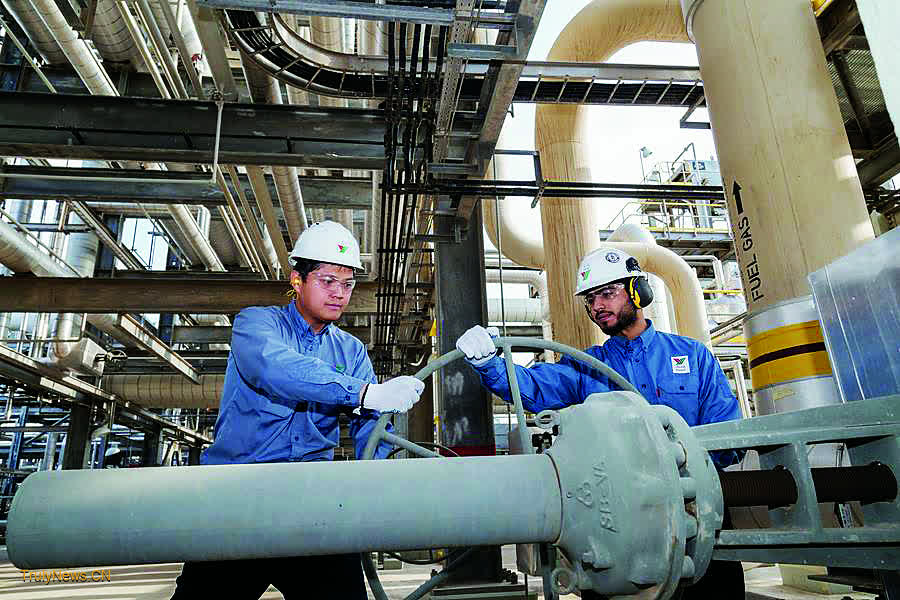
Driven by rising petrochemical consumption in Asia’s emerging economies, especially China, Saudi Arabian Oil Company, Saudi Aramco, has vowed to further expand its liquids-to-chemicals business in the region to meet growing demand while guaranteeing long-term supply of crude oil from Saudi Arabia, the world’s largest exporter of crude.
“With the global petrochemical landscape rapidly evolving and demand growth anticipated to accelerate, Saudi Aramco will continue to grow our liquids-to-chemicals business, with a goal to increase throughput in integrated refining and petrochemicals complexes to up to four million barrels per day — up from two million a day currently,” said Yasser M Mufti, executive vice-president of products and customers at Saudi Aramco.
“We expect to see growth driven by rising consumption from Asia’s emerging economies and Saudi Aramco already has new investments, such as the Gulei project, a $10 billion mega oil-refining and petrochemical project that began construction in late November in East China’s Fujian province, the largest industrial investment in Fujian to date,” he said.
Expected to be fully operational by 2030, the project, a collaboration between China Petroleum & Chemical Corp, Saudi Aramco and Fujian Petrochemical Co Ltd, is a significant milestone in China-Saudi energy collaboration. It aims to have a 16 million metric ton-per-year oil refining unit, a 1.5 million ton-per-year ethylene unit, 2 million tons in paraxylene and downstream derivatives capacity, and a 300,000-ton crude oil terminal.
“The project is key to downstream expansion as we continue to provide chemicals to some of the largest and fastest-growing economies in the world,” said Mufti.
“As a big believer in China’s long-term potential with a positive view of the Chinese economy going forward, we are confident of the great value in ongoing investments as well as helping China to realize its ambition of transforming its economy and enabling growth and prosperity to the Chinese people,” he said.
The liquids-to-chemicals strategy is a way in which energy companies turn oil or other liquid fuels into chemicals that are used to make everyday products like plastics, detergents and fabrics. This comes at a time when demand for oil as fuel, like gasoline for cars, is projected to decrease gradually once renewable energy and electric vehicles become more popular, even as that of chemicals used in manufacturing everyday items is growing.
Aramco sees the use of goods such as plastics outlasting the growth in consumption of gasoline and diesel amid the energy transition, with much of the expansion in chemicals likely coming from Asia.
The company expects global oil demand to reach 106 million barrels per day by the end of 2025, with 65 percent of that growth driven by Asia.
“Total demand in China is expected to reach 17.4 million barrels per day in fiscal year 2024 and 17.7 million barrels per day in fiscal year 2025, driven by jet fuels and petrochemicals as we see resilient export volumes and increased aviation traffic,” said Mufti.
With chemical product demand in China expected to grow along with economic recovery, multinational chemical corporations like Aramco and BASF have been prioritizing downstream assets in the country, an analyst said.
The focus on the Asia Pacific, especially China, is rooted in the expectation of resilient chemical demand growth in the region, said Hong Luxi, head of downstream oil and chemicals at BloombergNEF.
China is currently a powerhouse representing 40 percent of global chemical product sales. Eyeing the potential opportunities, Saudi Aramco has been stepping up collaboration with domestic players in recent years, including the two agreements last year for multi-billion dollar liquids-to-chemicals investments in China — the acquisition of an interest in the Rongsheng Petrochemicals Co in Zhejiang province for $3.4 billion and a partnership in Liaoning province at a cost of $12 billion.
China is strategically important to Aramco’s business growth in Asia and worldwide and the company plans to continue expanding its presence here to support the country’s energy security and development trajectory, said Mufti.
He said, the ventures in China enable the company to help create new pathways for growth by driving the deeper integration of refining and petrochemical processes.
“We will continue to support China’s long-term energy security and economic growth, eyeing greater investment and cooperation opportunities amid the country’s high-quality development,” he said.
“Looking ahead, we see opportunities for further investments in integrated downstream projects spanning oil supply, refining, chemicals and lubricants.”